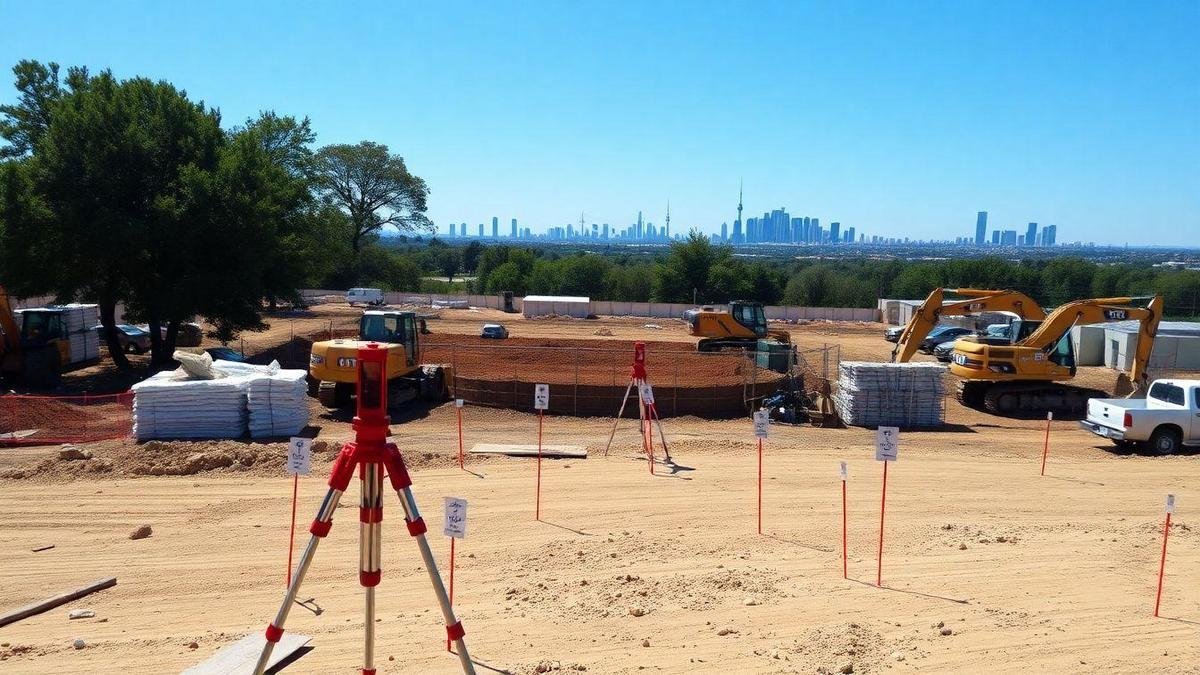Land development permits are essential for anyone looking to invest in real estate. This article explores what these permits are, their importance for investors, and the benefits they bring to development projects. It outlines the steps to secure these permits while navigating common challenges. Additionally, it offers tips for making the permitting process smoother and discusses the significance of zoning, site plan reviews, and land use planning. Understanding these components is crucial for successful investments in land development.
Key Insights
- Understanding land development permits is crucial for investors.
- Different projects require different types of permits.
- Research local regulations to avoid delays.
- Prepare all necessary documents ahead of time.
- Engage with professionals for smoother processes.

Understanding Land Development Permits
What Are Land Development Permits?
Land development permits are essential approvals required before starting construction or land alteration projects. These permits are issued by local governments and ensure that the planned development complies with zoning laws, environmental regulations, and safety standards. They act as a green light, signaling that a project can move forward without legal hurdles.
Importance of Land Development Permits for Investors
For investors, obtaining land development permits is crucial. These permits protect investments and provide a clear path for development. Without them, investors risk facing fines, delays, or even the complete halt of their projects.
Investors who navigate the permitting process effectively can save time and money and gain a competitive edge, as having the necessary permits often attracts buyers or tenants. For more insights into maximizing returns, consider exploring ROI in land development.
Key Benefits of Securing Land Development Permits
Securing land development permits offers several advantages:
| Benefit | Description |
|---|---|
| Legal Compliance | Ensures the project adheres to all local laws and regulations. |
| Increased Property Value | Proper permits can enhance the value of the property. |
| Streamlined Process | Helps avoid delays and potential legal issues down the line. |
| Market Trust | Investors show credibility by having the right approvals. |
In summary, land development permits are not just paperwork; they are the backbone of successful land development. Investors who prioritize securing these permits position themselves for smoother projects and greater returns.

The Easy Permitting Process
Steps to Obtain Land Development Permits
Obtaining land development permits can be a straightforward journey if one follows the right steps. Here’s a clear outline of the process:
- Research Local Regulations: Each area has its own rules. Understanding these is crucial.
- Prepare Necessary Documents: Gather all required paperwork, including site plans and environmental assessments.
- Submit Application: Fill out the application form accurately and submit it to the local authority.
- Public Review: Often, there is a period for public comments. This allows the community to voice concerns or support.
- Approval or Denial: After review, the authority will either approve or deny the application. If denied, they will provide reasons.
- Address Conditions: If approved, there may be conditions to meet before starting development.
Common Challenges in the Permitting Process
While the process can be simple, challenges may arise. Here are some common hurdles:
- Incomplete Applications: Missing documents can delay the process.
- Public Opposition: Local residents may oppose the project, leading to additional reviews.
- Changing Regulations: Laws can shift, causing confusion and requiring additional adjustments.
- Environmental Concerns: Projects near sensitive areas may face strict scrutiny.
Tips for Navigating the Easy Permitting Process
To make the permitting process smoother, consider these tips:
- Engage Early: Contact local officials before submitting the application. This can clarify expectations.
- Be Thorough: Double-check all documents for completeness. A small mistake can cause delays.
- Communicate with Neighbors: Informing the community about the project can reduce opposition.
- Stay Updated: Keep abreast of any changes in local regulations that may affect the project.
| Tip | Description |
|---|---|
| Engage Early | Contact officials for clarity on requirements. |
| Be Thorough | Ensure all documents are complete before submission. |
| Communicate with Neighbors | Build support to minimize opposition. |
| Stay Updated | Monitor changes in regulations that could impact plans. |

Investor-Friendly Land Permits
Features of Investor-Friendly Land Permits
Investor-friendly land permits are crafted to simplify the process of acquiring land for development. These permits often include streamlined application processes, clear guidelines, and favorable zoning regulations. Here are some key features:
- Simplified Applications: Investors can navigate the application process with ease, reducing time and effort.
- Transparent Guidelines: Clear information helps investors understand what is needed for approval.
- Flexible Zoning: Allows for diverse development options, catering to various investor needs.
- Fast-Track Approvals: Some regions offer expedited reviews for projects that meet specific criteria.
How Investor-Friendly Permits Benefit Development Projects
Investor-friendly permits play a crucial role in enhancing development projects. They provide several advantages:
- Reduced Timeframes: Faster approvals mean projects can start sooner, leading to quicker returns on investment.
- Lower Costs: With less red tape, investors save on potential delays and additional costs.
- Increased Investment Appeal: Attractive permitting processes draw in more investors, boosting local economies.
- Enhanced Collaboration: Clear communication between investors and local governments fosters better relationships.
Examples of Successful Investor-Friendly Land Permits
Several regions have implemented successful investor-friendly land permits. Here are a few notable examples:
| Location | Permit Type | Benefits |
|---|---|---|
| Austin, Texas | Fast-Track Development Permit | Reduces approval time by 50% |
| Miami, Florida | Flexible Zoning Permit | Attracts mixed-use developments |
| Denver, Colorado | Streamlined Application Process | Lowers project initiation costs |
These examples showcase how effective land development permits can lead to successful projects and satisfied investors.

Understanding Land Development Regulations
Overview of Key Land Development Regulations
Land development regulations are the backbone of any successful investment in real estate. These laws govern how land can be used and what can be built on it. Key regulations include zoning laws, building codes, and environmental regulations.
- Zoning Laws: These dictate what types of buildings can be constructed in certain areas. For instance, residential zones may not allow commercial buildings.
- Building Codes: These set the standards for construction quality and safety. They cover aspects like structural integrity, plumbing, and electrical systems.
- Environmental Regulations: These protect natural resources. They may require assessments to ensure that development does not harm the environment.
Understanding these regulations is crucial for investors. They not only dictate what can be done but also influence the overall value of the property. For a deeper dive into zoning laws, check out Zoning in the U.S.
How Regulations Impact Investment Decisions
Regulations can significantly influence investment choices. Investors must consider how these laws affect potential profits and risks. For example, a property in a highly regulated area may require more time and money to develop due to strict zoning laws or environmental assessments.
Here’s how regulations can impact decisions:
| Factor | Impact |
|---|---|
| Cost of Compliance | Increased costs for permits and inspections. |
| Time Delays | Longer approval processes can slow down projects. |
| Market Value | Properties in well-regulated areas may have higher values. |
Navigating these regulations can feel like walking through a maze. Investors must stay informed to avoid costly mistakes.
Staying Compliant with Land Development Regulations
Staying compliant is essential for any investor. Non-compliance can lead to fines, legal issues, or even the loss of property. Here are some tips to maintain compliance:
- Research Local Laws: Know the specific regulations in the area of investment.
- Hire Experts: Engage with local planners or legal advisors who specialize in land development.
- Obtain Necessary Permits: Before starting any project, securing land development permits is crucial.
- Stay Updated: Regulations can change, so keeping abreast of any updates is vital.
By following these steps, investors can navigate the complexities of land development regulations with confidence.

Streamlining Land Permits for Efficiency
Techniques to Streamline the Permitting Process
Streamlining land development permits is essential for investors looking to maximize their opportunities. One effective technique is to establish clear checklists that outline all necessary steps in the permitting process. This helps avoid confusion and keeps projects on track. Another technique is to foster collaboration among different departments and agencies. By encouraging open communication, stakeholders can address issues before they become roadblocks.
Additionally, pre-application meetings can be beneficial. These meetings allow developers to present their ideas early on and receive feedback from officials. This proactive approach can save time and reduce the chances of costly revisions later.
The Role of Technology in Streamlining Land Permits
Technology plays a crucial role in making the permitting process more efficient. Online platforms can simplify applications, allowing developers to submit documents digitally. This not only saves time but also reduces paperwork.
Moreover, Geographic Information Systems (GIS) can help visualize land use and zoning regulations. This technology allows investors to assess sites quickly and make informed decisions. For tools that can aid developers, explore tools for developers in the U.S.
| Technology | Benefits |
|---|---|
| Online Application Systems | Reduces paperwork and speeds up submission |
| GIS Mapping | Enhances site assessment and decision-making |
Benefits of a Streamlined Land Permit Process
A streamlined land permit process offers numerous advantages. First, it saves time. When permits are processed quickly, projects can move forward without unnecessary delays. Second, it can lead to cost savings. Fewer delays mean lower holding costs for investors.
Lastly, a smooth permitting process builds trust between developers and government agencies. This trust can lead to more successful projects in the future, creating a win-win situation for all parties involved.

Permit Application Tips for Investors
Essential Documents for Permit Applications
When investors embark on the journey of land development permits, having the right documents is crucial. The following list highlights the essential documents needed for a successful application:
- Site Plans: Detailed layouts showing property lines, structures, and landscaping.
- Environmental Assessments: Reports evaluating the impact of the proposed development on the environment.
- Zoning Compliance: Documentation proving that the project aligns with local zoning laws.
- Engineering Reports: Technical documents that address infrastructure requirements.
- Financial Statements: Proof of funding and investment capacity.
Common Mistakes to Avoid in Permit Applications
Mistakes can be costly in the permit application process. Investors should be wary of the following common pitfalls:
- Incomplete Applications: Submitting applications without all required documents can lead to delays.
- Ignoring Local Regulations: Failing to understand local laws can result in rejections.
- Underestimating Timeframes: Not accounting for the time needed for reviews can stall projects.
- Neglecting Community Input: Overlooking feedback from local residents can cause opposition.
Best Practices for Successful Permit Applications
To navigate the complexities of permit applications, investors should adopt these best practices:
- Research Thoroughly: Understand local regulations and requirements before starting the application.
- Engage with Local Authorities: Building relationships can facilitate smoother interactions and approvals.
- Prepare for Public Hearings: Be ready to address community concerns and present the benefits of the project.
- Stay Organized: Keep all documents and correspondence in order to avoid confusion.
| Best Practice | Description |
|---|---|
| Research Thoroughly | Know the rules and regulations before applying. |
| Engage with Authorities | Build relationships with local officials. |
| Prepare for Hearings | Anticipate questions and community feedback. |
| Stay Organized | Maintain clear records of all documents and contacts. |

Navigating the Zoning Approval Process
Understanding Zoning Laws and Their Impact
Zoning laws are the rules that dictate how land can be used. They can shape what a piece of land can become. For investors, understanding these laws is crucial. Zoning laws can affect property values, development options, and even the timeline for projects. For instance, if a piece of land is zoned for residential use, it cannot be developed for commercial purposes without going through a rezoning process.
Steps to Secure Zoning Approval
Securing zoning approval can feel like walking a tightrope, but breaking it down into steps can simplify the process:
- Research Local Zoning Regulations: Start by checking the local zoning ordinances. This will help identify the current zoning classification of the property.
- Develop a Proposal: Create a detailed proposal that outlines the intended use of the property. Include how it will benefit the community.
- Engage with the Community: Before submitting the application, it can be helpful to engage with local residents. Their support can be instrumental.
- Submit the Application: File the zoning application with the local zoning board. Be sure to include all required documents.
- Attend Public Hearings: Be prepared to present the proposal at public hearings. This is the time to answer questions and address concerns.
- Await Approval: After the hearings, the zoning board will review the application and make a decision.
| Step | Description |
|---|---|
| 1 | Research Local Zoning Regulations |
| 2 | Develop a Proposal |
| 3 | Engage with the Community |
| 4 | Submit the Application |
| 5 | Attend Public Hearings |
| 6 | Await Approval |
Importance of Zoning Approval in Land Development
Zoning approval is a critical step in land development. Without it, projects can stall or even fail. Zoning approval not only legitimizes the project but also builds trust with investors and the community. It lays the groundwork for successful development and can enhance property values. For example, a developer who secures zoning approval for a mixed-use project can attract businesses and residents, creating a vibrant community.

Site Plan Review Essentials
What is a Site Plan Review?
A Site Plan Review is a critical process in land development. It involves examining a proposed development’s layout to ensure it meets local regulations and standards. This review focuses on how the land will be used, including buildings, parking, landscaping, and other features. It acts as a blueprint, guiding developers and planners toward a successful project.
Key Elements of a Successful Site Plan
To create a successful site plan, several key elements must be included:
- Zoning Compliance: The plan must adhere to local zoning laws.
- Site Layout: This includes the arrangement of buildings, roads, and open spaces.
- Traffic Flow: Analyzing how vehicles and pedestrians will move around the site is crucial.
- Utilities: Proper planning for water, electricity, and sewage is essential.
- Environmental Impact: Understanding how the development affects the surrounding environment is important.
| Element | Description |
|---|---|
| Zoning Compliance | Adherence to local laws and regulations |
| Site Layout | Arrangement of buildings and open spaces |
| Traffic Flow | Analysis of movement for vehicles and pedestrians |
| Utilities | Planning for essential services like water and power |
| Environmental Impact | Assessment of effects on the natural surroundings |
Importance of Site Plan Review in Land Development Permits
The Site Plan Review is vital for obtaining land development permits. It acts as a checkpoint that ensures all aspects of the project meet the necessary guidelines. Without a thorough review, projects may face delays or even rejections.
Moreover, a well-executed site plan can save time and money by identifying potential issues early on. This proactive approach helps developers navigate the often complex landscape of regulations, making the process smoother and more efficient.

The Role of Land Use Planning
Basics of Land Use Planning
Land use planning is a strategic process that helps communities decide how to use their land. This process involves analyzing the needs of the community, the environment, and the economy. Planners look at zoning laws, which dictate what types of buildings can go where. They also consider factors like transportation, parks, and schools. The goal is to create a balanced community where people can live, work, and play.
How Land Use Planning Affects Development Projects
Land use planning plays a crucial role in development projects. It lays the groundwork for what can be built and where. For developers, understanding these plans is vital. If they ignore land use regulations, they could face delays or even denial of land development permits.
Here are some ways land use planning impacts development:
- Location: Planners often designate areas for residential, commercial, or industrial use. Developers must align their projects with these designations.
- Infrastructure: Land use plans consider existing roads, water systems, and utilities. Developers need to ensure their projects fit into this framework.
- Community Needs: Planners aim to meet the needs of the community, such as parks or schools. Developers should consider these needs when designing projects.
Integrating Land Use Planning with Development Permits
Integrating land use planning with development permits is essential for successful projects. When developers apply for permits, they must show how their plans comply with local land use regulations. This integration can streamline the process and reduce potential roadblocks.
| Step | Description |
|---|---|
| Research | Understand local land use plans and regulations. |
| Design | Create project designs that align with planning goals. |
| Submit Application | Apply for development permits, demonstrating compliance. |
| Review Process | Engage with local authorities for feedback and adjustments. |
| Approval | Obtain necessary permits for construction to begin. |
By following these steps, developers can navigate the complexities of land use planning. This approach not only enhances project feasibility but also fosters positive community relations.
Conclusion
In conclusion, land development permits are the cornerstone of successful real estate investments. They provide essential legal compliance, enhance property value, and streamline the development process. Investors who take the time to understand the intricacies of these permits, including local regulations, zoning laws, and site plan requirements, position themselves for greater success in their projects. By engaging with local authorities, preparing thorough documentation, and staying informed about community needs, investors can navigate the permitting landscape with confidence. Ultimately, securing the right permits not only protects investments but also fosters trust and collaboration between developers and the community. For those eager to dive deeper into the world of land development and investment strategies, further insights await at Land Development Hub.

No responses yet